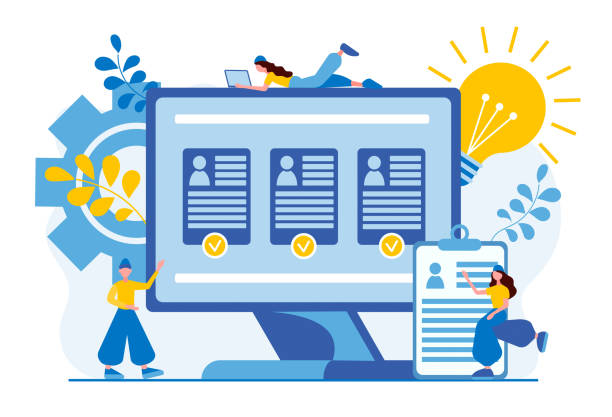The Importance of Speed in Today’s Web World

In the current digital age, website speed is not just an advantage, but a vital necessity.
#Fast_Website_Design is no longer a luxury option, but rather the foundation of success for any online business.
Internet users have high expectations for page loading speed, and even a few seconds of delay can lead to the loss of visitors and potential customers.
Research has shown that most users abandon a page if it doesn’t load within three seconds.
This user behavior directly impacts the site’s bounce rate, and a higher bounce rate indicates that your website has not been able to meet visitors’ needs quickly.
The importance of this issue is such that search engines like Google consider site speed as one of the SEO ranking factors.
A slow website not only offers a poor user experience but also reduces your chances of being seen in search results.
The goal of fast website design is to create a smooth and frictionless experience for the user, leading to increased engagement, conversion rates, and ultimately business success.
This is an explanatory and highly critical topic that every developer and business owner should pay special attention to.
Therefore, to remain competitive in today’s market, investing in website speed optimization is inevitable.
Tired of your company’s website not getting the visibility it deserves and losing potential customers? Solve this problem forever with professional and effective website design by Rasawp!
✅ Increase brand credibility and build customer trust
✅ Attract targeted sales leads
⚡ Contact us now for a free consultation!
Key Factors Affecting Website Performance
![]()
To achieve #Fast_Website_Design, understanding the factors affecting website speed is essential.
This section specifically addresses the technical components that impact your site’s performance.
The first important factor is web hosting.
Choosing a reputable hosting provider with powerful and optimized servers has a significant impact on loading speed.
Slow servers, even with optimized code, cannot provide adequate performance.
The second factor is the size and optimization of images and media.
Large and uncompressed images are among the biggest reasons for slow websites.
Using modern image formats like WebP and proper compression can significantly increase speed.
The third item is optimized and standard coding.
Voluminous, unnecessary, or render-blocking JavaScript and CSS codes can delay page loading.
Compressing and concatenating CSS and JS files, as well as asynchronous (async/defer) loading of scripts, are effective solutions.
The fourth factor is Caching.
Utilizing caching mechanisms on both the server-side and browser-side ensures that static site content is more quickly accessible for subsequent user visits or repeated requests, reducing the need for re-loading from the server.
These specialized and educational approaches form the foundation of a high-speed website.
Tools for Measuring and Optimizing Website Speed

To achieve a #Fast_Website_Design, we must first evaluate the current speed of our website and then optimize it using appropriate tools.
In this educational and guiding section, we introduce the most important speed measurement tools.
Google PageSpeed Insights is one of the most widely used tools, provided by Google, offering scores and suggestions for improvement for both desktop and mobile versions.
This tool examines metrics such as Largest Contentful Paint (LCP), First Input Delay (FID), and Cumulative Layout Shift (CLS), which are known as Core Web Vitals.
Another tool is GTmetrix, which provides more detailed reports, including a Waterfall Chart, helping you analyze each request individually and identify weaknesses.
Pingdom Tools is also a tool similar to GTmetrix that tests website loading speed from different locations around the world and provides useful information about page size and the number of requests.
Furthermore, browser developer tools (like Chrome DevTools) also have powerful capabilities for examining performance and identifying bottlenecks.
Proper use of these tools is the first step towards optimizing website speed and achieving a fast and efficient website.
Website Speed Analysis Tools
| Tool Name | Key Features | Best For |
|---|---|---|
| Google PageSpeed Insights | Core Web Vitals scoring, optimization suggestions | Quick analysis, general guidance |
| GTmetrix | Waterfall chart, comprehensive report, loading speed, PageSpeed/YSlow scores | Deep technical analysis, bottleneck identification |
| Pingdom Tools | Tests from different locations, page size, number of requests | Global user perspective review |
| WebPageTest | Advanced testing with various settings (browser, internet speed) | Complex scenario testing, A/B comparison |
Best Practices for Achieving High Speed in Web Design

After identifying the causes of slowness, it’s time to implement best practices for #Fast_Website_Design.
This section provides practical and expert guidance for improving your site’s performance.
The first and perhaps most important step is image optimization.
Using images with appropriate dimensions, compressing them without significant quality loss, and utilizing modern formats like WebP can drastically reduce page size.
Furthermore, implementing Lazy Loading for images and videos ensures that content is only loaded when the user needs it (i.e., when it enters their viewport).
Second, compressing CSS, JavaScript, and HTML files.
This process, called Minification, reduces file sizes by removing unnecessary characters (such as whitespace, comments, and newlines).
Third, utilizing browser caching to store your site’s static content in the user’s browser, eliminating the need for re-downloading on subsequent visits.
Fourth, reducing the number of HTTP requests by concatenating CSS and JavaScript files and using CSS Sprites for small images.
These educational and guiding techniques help you provide a much better user experience for your visitors and have a high-performing website.
How much does losing business leads due to an unprofessional website cost you? Solve this problem forever with professional corporate website design by Rasawp!
✅ Increase credibility and trust of potential customers
✅ Easier attraction of new business leads
⚡ Get a free consultation now!
The Impact of Site Speed on User Experience and SEO Ranking

#Fast_Website_Design is not just a technical metric, but a crucial factor for commercial success and digital marketing.
This analytical section examines the direct relationship between site speed, user experience (UX), and SEO.
From a user experience perspective, a slow website quickly discourages users and drastically increases the Bounce Rate.
Today’s users are impatient and tend to obtain the information they need in the shortest possible time.
When a site loads with delay, it not only causes dissatisfaction but also registers your brand in the user’s mind as unprofessional or outdated.
In contrast, a fast website conveys a sense of efficiency and modernity, increases user engagement, and boosts the likelihood of converting visitors into customers.
On the other hand, from an SEO perspective, site speed is a key ranking factor.
Search engines like Google prioritize faster websites to provide the best experience to their users.
Websites that score lower on Core Web Vitals metrics may be moved to lower ranks in search results.
This means that even if your content is excellent, a slow site can prevent it from being seen.
Therefore, investing in site speed optimization is an investment in the future of your online business, as it directly impacts customer satisfaction and your visibility in search engines.
Choosing the Right Hosting and Utilizing CDN

One of the fundamental steps in #Fast_Website_Design is choosing the right infrastructure.
This section specifically and instructively addresses the importance of choosing suitable hosting and utilizing Content Delivery Networks (CDN).
Choosing quality hosting tailored to your site’s needs is the first pillar of a fast website.
Shared hosting may be suitable for starting, but for websites with high traffic or extensive content, Virtual Private Servers (VPS), dedicated servers, or Cloud Hosting are better options.
Factors such as server location (close to your target audience), bandwidth, storage type (SSD instead of HDD), and technical support play a key role in choosing hosting.
The second important element is Content Delivery Network (CDN).
A CDN is a system of distributed servers worldwide that stores cached copies of your website’s static content (such as images, CSS, JavaScript) and delivers it from the server closest to the user.
This reduces the distance data travels, resulting in a significant increase in loading speed for users in different geographical locations.
CDN also offers security benefits and reduces the load on the main server.
The correct selection and implementation of these two factors play a significant role in improving overall performance and achieving a fast and efficient website.
Mobile-First Design and its Role in Website Speed

In today’s mobile-first world, #Fast_Website_Design with a Mobile-First Design approach has gained special importance.
This news and expert section examines this approach and its impact on website performance.
Mobile-first means that in the design and development process, we first consider the experience of mobile users, and then extend the design to larger devices like tablets and desktops.
This approach not only ensures your site displays optimally on smaller devices but also naturally leads to lighter and more optimized structures and code, directly impacting loading speed.
Designing for mobile means reducing unnecessary elements, optimizing images for smaller screens, and using smaller-sized web fonts.
Projects like AMP (Accelerated Mobile Pages), supported by Google, are also designed with the goal of creating super-fast web pages for mobile.
AMP makes it possible to load pages in a fraction of a second by restricting certain HTML and JavaScript functionalities.
Given that a large portion of internet traffic comes from mobile, focusing on optimizing websites for mobile is not just a choice but a necessity, directly tied to the concept of fast website design.
Comparison of Responsive Design and AMP
| Feature | Responsive Design | AMP (Accelerated Mobile Pages) |
|---|---|---|
| Main Goal | Proper display on all devices with a single codebase | Super-fast content loading on mobile |
| Method of Operation | Using CSS Media Queries to change layout | HTML and JS limitations, Google cache |
| Flexibility | High, full design capabilities | Limited, focus on speed and content |
| Speed | Very good with proper optimization | Exceptional, instant loading |
| Implementation Complexity | Medium | More complex due to limitations, requires a separate version |
Common Web Design Mistakes That Lead to Slow Websites

On the path to #Fast_Website_Design, recognizing common mistakes that can degrade site performance is of paramount importance.
This educational and explanatory section helps you avoid these pitfalls.
One of the biggest mistakes is lack of image optimization.
Many designers and developers place images on sites without proper compression or resizing, which can drastically increase page size.
Another common mistake is excessive use of unnecessary plugins and scripts.
Each additional plugin or script creates new HTTP requests and may load heavy JavaScript code that slows down the site.
This problem is particularly common in Content Management Systems like WordPress.
Lack of proper caching, both on the server-side and in the user’s browser, is also one of the main reasons for slow websites.
Every time a user visits a page without caching, all content must be reloaded.
Also, choosing cheap and low-quality hosting, often in hopes of saving costs, is one of the most destructive mistakes that can nullify all efforts to optimize speed.
Finally, not having a regular plan for continuous site maintenance and optimization will also lead to performance degradation over time.
Awareness of these mistakes and avoiding them is a big step towards achieving a fast and optimized website.
Did you know that 85% of customers check your company’s website before any interaction?
With Rasawp, build a corporate website that befits your reputation.
✅ Increase credibility and customer trust
✅ Attract high-quality leads
⚡ Get a free website design consultation
The Future of Web Performance and New Trends in Site Speed

With the continuous advancement of technology, the future of #Fast_Website_Design is also evolving.
This news and thought-provoking content explores new trends and technologies that are set to revolutionize our definition of web speed.
One of the most important trends is advancements in Core Web Vitals and their growing importance by search engines.
Google continuously updates its algorithms for ranking websites based on user experience, especially speed.
Therefore, the future is moving towards websites that not only load quickly but also have high interactivity and visual stability.
New technologies like HTTP/3, based on the QUIC protocol, promise to make web communications much faster and more efficient than the current HTTP/2.
These protocols can significantly reduce latency and improve the concurrent loading of resources.
Also, increased use of Service Workers and Progressive Web Apps (PWAs) plays a significant role in creating offline experiences and instant content loading, directly impacting speed and accessibility.
The question is whether websites will become so fast in the future that the concept “loading” completely disappears, and users will have an instant experience of content? It is predicted that with the development of Artificial Intelligence in server-side and client-side optimizations, achieving unprecedented speeds will be possible.
Site Maintenance for Sustainable Speed

#Fast_Website_Design is not a one-time project, but an ongoing process.
This explanatory and engaging section discusses the importance of continuous website maintenance to ensure its sustainable speed.
Just like a car that needs regular service and maintenance, your website also requires constant care to maintain its optimal performance.
Regular updates of the platform (like WordPress), plugins, and site theme are the first essential step.
These updates often include security and performance enhancements that can help maintain site speed.
Periodic database review and optimization are also crucial for removing extra data and improving server response speed.
Scattered or unnecessary data can cause slowness over time.
Furthermore, continuous monitoring and supervision of site performance using speed measurement tools (as mentioned earlier) are essential.
This allows you to quickly detect any drop in speed and address it before it affects user experience.
Regular clearing of cache files and server cache is also important to ensure that the latest version of the site is delivered to users.
Finally, regular checking for broken links and corrupted images, and replacing or removing them, not only aids SEO but also prevents loading useless requests and maintains your website’s speed.
Maintaining this proactive approach ensures that your fast website always remains at its peak performance.
Frequently Asked Questions
| No. | Question | Answer |
|---|---|---|
| 1 | What is the concept of “Fast Website Design”? | Designing a website that loads as quickly as possible and provides a smooth user experience, with an emphasis on performance optimization. |
| 2 | Why is website loading speed important for users? | Today’s users have little patience; slow websites lead to early page abandonment, poor user experience, and loss of visitors. |
| 3 | How does fast website design affect SEO? | Search engines like Google consider site speed as one of the ranking factors. Faster websites achieve better rankings in search results. |
| 4 | What are the main factors affecting site speed? | Image optimization, caching, compression of CSS and JS files, use of powerful hosting, reduction of HTTP requests, and optimized coding. |
| 5 | How can website loading speed be measured? | By using tools like Google PageSpeed Insights, GTmetrix, Lighthouse, and Pingdom Tools, which provide detailed reports on site performance. |
| 6 | What is the role of images in site speed and how should they be optimized? | High-volume images can severely reduce site speed. They should be compressed, modern formats (like WebP) should be used, and the Lazy Load technique should be employed. |
| 7 | What is the importance of choosing appropriate hosting in fast website design? | A powerful and high-speed hosting (preferably SSD) with optimized servers close to target users is the foundation of a site’s speed. |
| 8 | How does Caching help increase site speed? | Caching allows the user’s browser to store copies of site files, so on subsequent visits, there’s no need to re-load all content, and the site displays faster. |
| 9 | Is using a CDN (Content Delivery Network) recommended in fast website design? | Yes, CDN significantly increases loading speed by storing copies of site content on various geographical servers and delivering it from the server closest to the user. |
| 10 | What are the key tips for developers to design a high-speed website? | Writing clean and optimized code, minimal use of plugins, optimizing database queries, using lightweight frameworks, and implementing Lazy Load for content. |
And other services of Rasawp Advertising Agency in the field of advertising
Smart SEO: Revolutionize online growth with Google Ads management.
Smart Marketing Automation: An effective tool to improve SEO ranking with precise audience targeting.
Smart Conversion Rate Optimization: A professional solution for user engagement focusing on custom programming.
Smart Advertising Campaign: A creative platform to improve customer acquisition by customizing user experience.
Smart Brand Identity: Revolutionize click-through rate increase with intelligent data analysis.
And over a hundred other services in the field of internet advertising, advertising consultation, and organizational solutions
Internet Advertising | Advertising Strategy | Advertorial
Sources
Importance of Site Speed in SEO SEO-Friendly Website Design 10 Important Principles of User Experience in Website Design 8 Tips for High-Speed Website Design
? Ready to revolutionize your business in the digital world? Rasawp Afarin Digital Marketing Agency, with expertise in website design with a modern user interface and comprehensive marketing strategies, is with you to have a powerful and effective online presence.
📍 Tehran, Mirdamad Street, next to Bank Markazi, Southern Kazeroun Alley, Ramin Alley, No. 6



